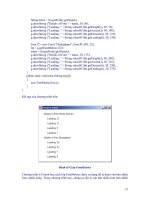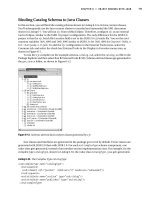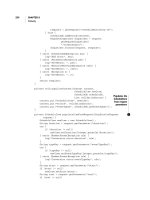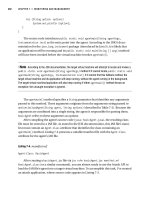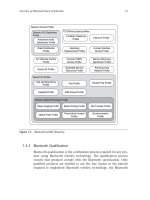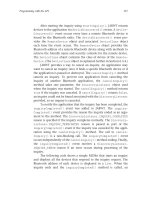Patterns in JavaTM, Volume 3 Java Enterprise Java Enterprise Design Patterns phần 6 pptx
Bạn đang xem bản rút gọn của tài liệu. Xem và tải ngay bản đầy đủ của tài liệu tại đây (337.95 KB, 50 trang )
stub’s method is called is that it creates a new connection. This can add
significant overhead to applications that make frequent remote method
calls. It can be a bottleneck that limits the number of clients a server can
handle concurrently. Virtualizing the connections eliminates most of the
overhead.
First we will look at the Multiplexer class.
public class Multiplexer {
private Socket actualSocket; // The actual connection.
private DataOutputStream actualOut; // actual output stream
private DataInputStream actualIn; // actual input stream
private Hashtable socketTable; // key is connection id
private ChunkBufferPool bufferPool;
ChunkBufferPool objects keep a collection of ChunkBuffer objects
that are awaiting reuse. A Multiplexer object asks its ChunkBufferPool
object for a ChunkBuffer object when it needs one. If the ChunkBufferPool
object has any ChunkBuffer objects in its collection, it takes one out of the
collection and gives it to the Multiplexer object. If the ChunkBufferPool
object does not have any ChunkBuffer objects in its collection, then it cre-
ates a new one. When a ChunkBuffer object is no longer needed, it is
returned to the ChunkBufferPool object. This is an application of the
Object Pool pattern described in Volume 1.
private Queue connectionQueue = new Queue();
When a Multiplexer object receives data associated with a new vir-
tual connection, it creates a Socket object and places it in a Queue object.
It stays in the Queue until a call to the Multiplexer object’s accept
method takes it out of the Queue object and passes it to its caller.
private ConnectionIDFactory idFactory;
This Multiplexer implementation delegates the creation of
ConnectionID objects to a class called ConnectionIDFactory.
private int connectionIDLength;
Multiplexer objects transmit ConnectionID objects as a sequence
of bytes. The Multiplexer object on one end of an actual connection may
create ConnectionID objects that are represented as a longer sequence of
bytes than the other. This may be due to environmental differences or
because the programs on each end of the actual connection are using dif-
ferent versions of the Multiplexer class.
Multiplexer objects must exchange connection IDs without regard
to which Multiplexer object created the connection ID. To accomplish
this, when two
Multiplexer objects begin working with each other, they
242
■
CHAPTER SIX
exchange the lengths of the connection IDs that they produce. They set the
value of their connectionIDLength instance variable to the larger of the
two lengths. They then force all of the connection IDs that they create to
be that length. If the natural length of a connection ID is less than this, it is
padded with zeros.
// This array of bytes is used to read bytes directly from
// the actual connection.
private byte[] inputBuffer;
The next three variables contain some of the parameters discussed
under the “Implementation” heading.
private int maxMessageLength; // Maximum number of data
// bytes to put in a message.
private int highWaterMark;
private int lowWaterMark;
Multiplexer objects communicate with each other by sending mes-
sages over the actual connection. Each message begins with an int value
that identifies the type of the message. If the value is a positive number,
the message contains data for a virtual connection and the value is the
number of data bytes in the message. The following negative values are
used to indicate other types of messages.
private static final int CLOSE_CONNECTION = -1;
private static final int BLOCK_WRITES = -2;
private static final int UNBLOCK_WRITES = -3;
private static final int MESSAGE_HEADER_LENGTH = 6;
The constructor for the Multiplexer class takes two arguments: The
first argument is the socket for the actual connection. The second argu-
ment is an object that encapsulates the parameters discussed in the
“Implementation” section that control the operation of the Multiplexer
object.
public Multiplexer(Socket actualSocket,
MultiplexerParameters parameters)
throws IOException {
this.actualSocket = actualSocket;
maxMessageLength = parameters.maxMessageLength;
highWaterMark = parameters.highWaterMark;
lowWaterMark = parameters.lowWaterMark;
actualSocket.setTcpNoDelay(false);
// Create a DataOutputStream to write to the actual
// connection
int myBufferSize
= MESSAGE_HEADER_LENGTH+maxMessageLength;
Distributed Computing Patterns
■
243
OutputStream out = actualSocket.getOutputStream();
BufferedOutputStream bout;
bout = new BufferedOutputStream(out, myBufferSize);
actualOut = new DataOutputStream(bout);
// Send the buffer size we are using to the Multiplexer
// object on the other side of the connection.
actualOut.writeInt(myBufferSize);
actualOut.flush();
// Create a DataInputStream to read from the actual
// connection. Use the buffer size sent by the other
// Multiplexer object.
InputStream in = actualSocket.getInputStream();
int otherBufferSize
= new DataInputStream(in).readInt();
BufferedInputStream bin;
bin = new BufferedInputStream(in);
actualIn = new DataInputStream(bin);
// Create a buffer for reading from the actual
// connection.
inputBuffer = new byte[otherBufferSize];
// Negotiate the length of a connection ID with the
// other Multiplexer object
idFactory = new ConnectionIDFactory(actualSocket);
actualOut.writeShort(idFactory.getByteSize());
actualOut.flush();
connectionIDLength = Math.max(idFactory.getByteSize(),
actualIn.readShort());
idFactory.setByteSize(connectionIDLength);
// Create a ChunkBufferPool object to
// manage ChunkBuffer objects.
bufferPool
= new ChunkBufferPool(parameters.maxBuffers,
maxMessageLength);
} // constructor(Socket)
/**
* Return the address of the remote host that the actual
* connection connects to.
*/
public InetAddress getRemoteAddress() {
return actualSocket.getInetAddress();
} // getRemoteAddress
/**
* Return the local address that the actual connection is
* connected to.
*/
public InetAddress getLocalAddress() {
return actualSocket.getLocalAddress();
} // getLocalAddress()
244
■
CHAPTER SIX
/**
* Create a virtual connection and return a socket object
* that encapsulates it.
*/
public Socket createConnection() throws IOException {
ConnectionID id = idFactory.createConnectionID();
MultiplexerSocket vsocket;
vsocket = new MultiplexerSocket(id, actualSocket,
this, bufferPool,
highWaterMark,
lowWaterMark);
socketTable.put(id, vsocket);
return vsocket;
} // createConnection()
/**
* Write a byte to the given virtual connection.
* @param connectionID The ConnectionID of the virtual
* connection to write to.
* @param b The byte to write to the virtual connection.
*/
void write(ConnectionID id, int b) throws IOException {
synchronized (actualOut) {
writeMessageHeader(1);
id.write(actualOut);
actualOut.write(b);
} // synchronized
} // write(ConnectionID, int)
/**
* Send a message to the Multiplexer sobject on
* the other end of the given virtual connection telling it
* to stop sending any more data messages.
*/
void startMoratorium(ConnectionID id) throws IOException {
synchronized (actualOut) {
writeMessageHeader(BLOCK_WRITES);
id.write(actualOut);
} // synchronized
} // startMoratorium(ConnectionID)
/**
* Send a message to the Multiplexer object on
* the other end of the given virtual connection telling it
* to resume sending data messages.
*/
void endMoratorium(ConnectionID id) throws IOException {
synchronized (actualOut) {
writeMessageHeader(UNBLOCK_WRITES);
id.write(actualOut);
} // synchronized
} // endMoratorium(ConnectionID)
Distributed Computing Patterns
■
245
/**
* Send a message to the Multiplexer object on
* the other end of the given virtual connection telling it
* that the virtual connection is closed.
*/
void endConnection(ConnectionID id) throws IOException {
// If this is being called in response to a
// CLOSE_CONNECTION message, the ConnectionID will
// already have been removed from socketTable
if (socketTable.get(id)!=null) {
synchronized (actualOut) {
socketTable.remove(id);
writeMessageHeader(CLOSE_CONNECTION);
id.write(actualOut);
} // synchronized
} // if
} // endConnection(ConnectionID)
/**
* Close this object and free its resources.
*/
void close() {
// close all of the sockets that depend on this object.
Enumeration ids = socketTable.keys();
while (ids.hasMoreElements()) {
try {
endConnection((ConnectionID)ids.nextElement());
} catch (Exception e) {
} // try
} // while
// Close the resources that this object uses.
try {
actualOut.close();
actualIn.close();
actualSocket.close();
} catch (Exception e) {
} // try
} // close
/**
* Write len bytes from the specified array,
* starting at index ndx to this output stream.
* @param connectionID The connectionID to write to.
* @param b the data.
* @param ndx the start offset in the data.
* @param len the number of bytes to write.
*/
void write(ConnectionID id,
byte b[],
int ndx,
int len) throws IOException {
synchronized (actualOut) {
246
■
CHAPTER SIX
writeMessageHeader(len);
id.write(actualOut);
actualOut.write(b, ndx, len);
} // synchronized
} // write(ConnectionID, byte[], int, int)
/**
* Flush output buffers associated with the given
* virtual connection.
*/
void flush(ConnectionID id) throws IOException {
// For now, there are no connectionID specific buffers.
actualOut.flush();
} // flush(int)
private void writeMessageHeader(int messageHeader)
throws IOException {
actualOut.writeInt(messageHeader);
} // writeMessageHeader(int)
private int readMessageHeader() throws IOException {
return actualIn.readInt();
} // readMessageHeader()
/**
* Create a socket for a virtual connection created at the
* other end of the actual connection. Put it in a queue
* where it will stay until it is accepted.
* @param id The ConnectionID for the new virtual
* connection.
* @return The queued socket
*/
private
MultiplexerSocket queueNewConnection(ConnectionID id)
throws SocketException {
MultiplexerSocket ms;
ms = new MultiplexerSocket(id, actualSocket,
this, bufferPool,
highWaterMark,
lowWaterMark);
socketTable.put(id, ms);
connectionQueue.put(ms);
return ms;
} // queueNewConnection(ConnectionID)
/**
* Accept a virtual connection. If there are no
* connections waiting to be accepted, then this method
* does not return until there is a connection to
* accept.
* @return The socket that encapsulates the accepted
* virtual connection.
*/
public Socket accept() throws InterruptedException {
Distributed Computing Patterns
■
247
return (Socket)connectionQueue.get();
} // accept()
/**
* Accept a virtual connection. If there are no
* connections waiting to be accepted then this method does
* not return until there is a connection to be accepted.
* @param t The number of milliseconds this method should
* wait for virtual connection before throwing an
* InterruptedException
* @return The socket that encapsulates the accepted
* virtual connection.
* @exception InterruptedException If the given number of
* milliseconds elapse without a connection
* being accepted or the current thread is
* interrupted.
*/
public Socket accept(int t) throws InterruptedException {
return (Socket)connectionQueue.get(t);
} // accept()
An instance of the private class, MessageDispatcher, is responsible
for reading messages from an actual connection and dispatching them to
the thread that will process them.
private class MessageDispatcher implements Runnable {
private Thread dispatcherThread;
private static final String THREAD_NAME
= "MultiplexerDispatcher";
MessageDispatcher() {
dispatcherThread = new Thread(this, THREAD_NAME);
dispatcherThread.start();
} // constructor()
/**
* Top-level message dispatching logic.
*/
public void run() {
Thread myThread = Thread.currentThread();
try {
while (!myThread.isInterrupted()) {
int messageHeader = readMessageHeader();
if (messageHeader>0) {
readDataMessage(messageHeader);
} else {
switch (messageHeader) {
case CLOSE_CONNECTION:
readCloseConnection();
break;
case BLOCK_WRITES:
readBlock();
break;
248
■
CHAPTER SIX
case UNBLOCK_WRITES:
readUnblock();
break;
} // switch
} // if
} // while
} catch (IOException e) {
// This Multiplexer object can no longer
// function, so close it.
close();
} // try
} // run()
/**
* Read the body of a data message, put the data in a
* ChunkBuffer object and associate the ChunkBuffer
* object with the virtual connection.
* @param length The number of data bytes that the
* message header says the message
* contains.
*/
private void readDataMessage(int length)
throws IOException {
ConnectionID id;
id = ConnectionID.read(actualIn,
connectionIDLength);
MultiplexerSocket vsocket;
vsocket = (MultiplexerSocket)socketTable.get(id);
if (vsocket==null) {
vsocket = queueNewConnection(id);
} // if
int messageLength = actualIn.readInt();
// The message length should not exceed the
// promised length, but allow for the possibility
// that it may be longer.
while (messageLength>inputBuffer.length) {
actualIn.readFully(inputBuffer, 0,
inputBuffer.length);
vsocket.queueBuffer(inputBuffer.length,
inputBuffer);
messageLength -= inputBuffer.length;
} // while
actualIn.readFully(inputBuffer, 0, messageLength);
vsocket.queueBuffer(messageLength, inputBuffer);
} // readMessageHeader()
/**
* Read and process a CLOSE_CONNECTION message.
*/
private void readCloseConnection() throws IOException {
ConnectionID id;
id = ConnectionID.read(actualIn,
Distributed Computing Patterns
■
249
connectionIDLength);
MultiplexerSocket vsocket;
vsocket =(MultiplexerSocket)socketTable.remove(id);
if (vsocket!=null) {
vsocket.close()
} // if
} // readCloseConnection()
/**
* Read and process a BLOCK_WRITES message.
*/
private void readBlock() throws IOException {
ConnectionID id;
id = ConnectionID.read(actualIn,
connectionIDLength);
MultiplexerSocket vsocket;
vsocket =(MultiplexerSocket)socketTable.get(id);
if (vsocket!=null) {
vsocket.blockWrites();
} // if
} // readBlock()
/**
* Read and process a UNBLOCK_WRITES message.
*/
private void readUnblock() throws IOException {
ConnectionID id;
id = ConnectionID.read(actualIn,
connectionIDLength);
MultiplexerSocket vsocket;
vsocket =(MultiplexerSocket)socketTable.get(id);
if (vsocket!=null) {
vsocket.unblockWrites();
} // if
} // readUnblock()
} // class MessageDispatcher
} // class Multiplexer
An instance of the ConnectionIDFactory class is responsible for
creating instances of the ConnectionID class. The information used to cre-
ate a ConnectionID object depends on the actual connection that the
ConnectionID is used with. A ConnectionIDFactory object encapsulates
that information.
class ConnectionIDFactory {
// Array of information common to all ConnectionID objects
// associated with the same actual connection
private byte[] commonInfo;
private static final int PORT_NUMBER_LENGTH = 2;
static final int SERIAL_NUMBER_LENGTH = 4;
private int counter = 0;
private int byteSize = -1;
250
■
CHAPTER SIX
TEAMFLY
Team-Fly
®
/**
* constructor.
* @param socket The socket that encapsulates the actual
* connection this object will produce
* ConnectionID objects for.
*/
ConnectionIDFactory(Socket socket) {
InetAddress inetAddress = socket.getLocalAddress();
byte[] address = inetAddress.getAddress();
// We include port number to allow for the possibility
// of one Multiplexer object working with multiple
// actual connections from the same host.
int port = socket.getLocalPort();
// Assume only 2 significant bytes in a port number and
// four bytes four bytes for a serial number
commonInfo
= new byte[address.length + PORT_NUMBER_LENGTH];
System.arraycopy(address, 0, commonInfo, 0,
address.length);
int portOffset = address.length;
commonInfo[portOffset] = (byte)port;
commonInfo[portOffset+1] = (byte)(port>>8);
} // constructor(Socket)
/**
* Return the number of bytes that will be used to read or
* write a ConnectionID created by this object.
*/
int getByteSize() {
if (byteSize == -1) {
return commonInfo.length+SERIAL_NUMBER_LENGTH;
} // if
return byteSize;
} // getByteSize()
/**
* Set the number of bytes that will be used to read or
* write a ConnectionID created by this object.
*/
void setByteSize(int newValue) {
byteSize = newValue;
} // setByteSize(int)
/**
* Create a new ConnectionID object.
*/
ConnectionID createConnectionID() {
synchronized (this) {
counter++;
} // synchronized
return new ConnectionID(commonInfo, counter);
Distributed Computing Patterns
■
251
} // createConnectionID()
} // class ConnectionIDFactory
ConnectionID objects identify virtual connections with information
passed to their constructor by the ConnectionIDFactory object that cre-
ates them. The identifying information is unique for at least the lifetime of
the actual connection.
class ConnectionID {
private byte[] id;
/**
* This constructor is intended to be called by a
* ConnectionIDFactory object that creates
* unique identifying information
* @param myId An array of bytes with content that uniquely
* identifies the local end of the actual
* connection.
* @param serialNum A value that uniquely identifies a
* virtual connection created on this end
* of the actual connection.
*/
ConnectionID(byte[] myId, int serialNum) {
int idLength = myId.length
+ ConnectionIDFactory.SERIAL_NUMBER_LENGTH;
id = new byte[idLength];
int serialNumberOffset = myId.length;
System.arraycopy(myId, 0, id, 0, serialNumberOffset);
switch (ConnectionIDFactory.SERIAL_NUMBER_LENGTH ) {
case 4:
id[serialNumberOffset+3] = (byte)(serialNum>>24);
case 3:
id[serialNumberOffset+2] = (byte)(serialNum>>16);
case 2:
id[serialNumberOffset+1] = (byte)(serialNum>>8);
case 1:
id[serialNumberOffset] = (byte)serialNum;
} // switch
} // constructor(byte[], int)
/**
* The constructor is called internally by the
* readConnectionID method to create ConnectionID objects
* from data in an input stream.
* @param myId An array of bytes with content that uniquely
* identifies the local end of the actual
* connection. This array is used directly by
* the new object and is not copied.
*/
private ConnectionID(byte[] myId) {
this.id = myId;
} // constructor(byte[])
252
■
CHAPTER SIX
/**
* Read a ConnectionID from the given InputStream.
* @param in The InputStream to read from.
* @param byteSize The number of bytes of id information to
* read. This is needed because each end of
* an actual connection may use a different
* number of bytes.
*/
static ConnectionID read(InputStream in,
int size) throws IOException {
byte[] id = new byte[size];
if (in.read(id, 0, size) != size) {
throw new IOException();
} // if
return new ConnectionID(id);
} // readConnectionID(InputStream)
/**
* Write the bytes of identifying information in this
* ConnectionID to the given OutputStream.
*/
void write(OutputStream out) throws IOException {
out.write(id);
} // writeConnectionId(OutputStream)
The ConnectionID class overrides the equals and hashCode meth-
ods it inherits from the Object class so that the identifying information in
ConnectionID objects can be used as the key in a Hashtable.
/**
* Return true if this method’s argument is a ConnectionID
* that contains the same byte values as this ConnectionID
* object.
*/
public boolean equals(Object obj) {
if (obj instanceof ConnectionID) {
ConnectionID other = (ConnectionID)obj;
if (id.length == other.id.length) {
for (int i=0; i<id.length; i++) {
if (id[i]!=other.id[i]) {
return false;
} // if
} // for
return true;
} // if length
} // if
return false;
} // equals(Object)
/**
* Return a hashcode based on the contents of this object.
*/
public int hashCode() {
Distributed Computing Patterns
■
253
long h = 1234;
for (int i = id.length; i >= 0; )
h ^= id[i] * (i + 1);
return (int)((h >> 32) ^ h);
} // hashCode()
} // class ConnectionID
ChunkBuffer objects are used to buffer input from a virtual connec-
tion until it is read by a ChunkedInputStream object.
class ChunkBuffer {
private byte[] buffer; // The actual buffer
private int firstFree; // Index of next byte to put
// content in.
private int firstContent; // Index of first byte content.
/**
* constructor
* @param capacity The number of bytes this object should
* be able to hold
*/
ChunkBuffer(int capacity) {
buffer = new byte[capacity];
} // constructor(int)
/**
* Return the capacity of this object.
*/
int getCapicity() { return buffer.length; }
/**
* Set the contents of this buffer.
* @param bytes Array of bytes to store in this object.
* @param offset The number of bytes before the content.
* @param length The number of content bytes.
* @return The number of bytes copied into this object.
*/
synchronized int setContent(byte[] bytes, int offset, int length) {
int freeByteCount = buffer.length - firstFree;
int copyCount = Math.min(freeByteCount, length);
System.arraycopy(bytes, offset,
buffer, firstFree,
copyCount);
firstFree += copyCount;
return copyCount;
} // setContent(byte[], int, int)
/**
* Retrieve some bytes of content from this object.
* @param bytes An array to copy the content into.
254
■
CHAPTER SIX
* @param offset The first position to copy content into.
* @param length The number of bytes of content requested.
* @return The actual number of bytes of content retrieved.
*/
synchronized int getContent(byte[] bytes, int offset, int length) {
int availableBytes = firstFree - firstContent;
int copyCount = Math.min(availableBytes, length);
System.arraycopy(buffer, firstContent,
bytes, offset,
copyCount);
firstContent += copyCount;
return copyCount;
} // getContent(byte[], int, int)
/**
* Return the number of data bytes available in this
* object.
*/
int available() {
return firstFree - firstContent;
} // available()
/**
* Force this ChunkBuffer object to be empty. This method
* is intended to be called for ChunkBuffer objects that were
* associated with a virtual connection that was closed.
*
* Since this method is intended to be called when no
* threads will be trying to get or set its content, the
* method is not synchronized.
*/
void makeEmpty() {
firstContent = 0;
firstFree = 0;
} // makeEmpty()
} // class ChunkBuffer
The MultiplexerSocket class is a subclass of Socket. It provides
access to the virtual connection it encapsulates that is transparent to
objects expecting to work with a Socket object. MultiplexerSocket
objects also provide a convenient place to queue ChunkBuffer objects
until their content can be read by a ChunkedInputStream object.
class MultiplexerSocket extends Socket {
private ArrayList chunkBufferQueue = new ArrayList();
private ChunkBufferPool bufferPool;
private int highWaterMark;
private int lowWaterMark;
private boolean moratoriumRequested = false;
private ConnectionID id;
private Multiplexer mux;
private MultiplexerSocketImpl impl;
Distributed Computing Patterns
■
255
/**
* This constructor is intended to be called only by
* Multiplexer objects.
*
* @param id The ConnectionID that identifies the virtual
* connection this socket is associated with to the
* local Multiplexer object.
* @param actual The socket that encapsulates the actual
* connection.
* @param mux The multiplexer object that owns this
* object.
* @param bufferPool The ChunkBufferPool that this object
* will get ChunkBuffer objects from.
* @param highWaterMark If the number of queued ChunkBuffer
* objects reaches this value, request
* the other end of the virtual
* connection to stop sending input.
* @param lowWaterMark After the number of queued
* ChunkBuffer objects reaches the
* highWaterMark value, request that
* the other end of the virtual
* connection resume sending input.
*/
MultiplexerSocket(ConnectionID id,
Socket actual,
Multiplexer mux,
ChunkBufferPool bufferPool,
int highWaterMark,
int lowWaterMark)
throws SocketException {
this(id, mux, bufferPool,
highWaterMark, lowWaterMark,
new MultiplexerSocketImpl(id, actual, mux));
} // constructor
The design of the java.net package calls for the Socket class and its
subclasses to delegate to a subclass of SocketImpl responsibility for inter-
facing with an actual transport mechanism. This MultiplexerSocket
class follows that architecture by delegating responsibility for transport to
the MultiplexerSocketImpl class.
/**
* This constructor is intended to be called only by
* the non-private constructor.
* @param id The ConnectionID that identifies the virtual
* connection this socket is associated with to the
* local Multiplexer object.
* @param mux The multiplexer object that owns this
* object.
* @param bufferPool The ChunkBufferPool that this object
* will get ChunkBuffer objects from.
* @param highWaterMark If the number of queued ChunkBuffer
256
■
CHAPTER SIX
* objects reaches this value, request
* the other end of the virtual
* connection to stop sending input.
* @param lowWaterMark After the number of queued
* ChunkBuffer objects reaches the
* highWaterMark value, request that
* the other end of the virtual
* connection resume sending input.
* @param impl The implementation object for this socket.
*/
MultiplexerSocket(ConnectionID id,
Multiplexer mux,
ChunkBufferPool bufferPool,
int highWaterMark,
int lowWaterMark,
MultiplexerSocketImpl impl)
throws SocketException {
super(impl);
this.id = id;
this.mux = mux;
this.bufferPool = bufferPool;
this.highWaterMark = highWaterMark;
this.lowWaterMark = lowWaterMark;
this.impl = impl;
impl.setMultiplexerSocket(this);
} // constructor(ConnectionID)
/**
* Put some buffered input bytes in a ChunkBuffer.
* @param byteCount The number of input bytes.
* @param buffer A byte array that contains the input
* @exception IOException if there is a problem
*/
synchronized void queueBuffer(int byteCount, byte[] buffer)
throws IOException {
// Before allocating a ChunkBuffer object for the
// input, check for an already queued ChunkBuffer
// object that has enough free space.
int queueSize = chunkBufferQueue.size();
int offset = 0;
if (queueSize>0) {
ChunkBuffer cb
= (ChunkBuffer)chunkBufferQueue.get(queueSize-1);
if (cb.available()>0) {
int size = Math.min(byteCount, cb.available());
cb.setContent(buffer, 0, size);
byteCount -= size;
offset = size;
} // if available
} // if queueSize
if (byteCount>0) {
ChunkBuffer cb = bufferPool.allocateChunkBuffer();
cb.setContent(buffer, offset, byteCount);
Distributed Computing Patterns
■
257
chunkBufferQueue.add(cb);
notify();
if (moratoriumRequested) {
if (chunkBufferQueue.size()<=lowWaterMark) {
mux.endMoratorium(id);
moratoriumRequested = false;
} // if lowWaterMark
} else {
if (chunkBufferQueue.size()>=highWaterMark) {
mux.startMoratorium(id);
moratoriumRequested = true;
} // if highWaterMark
} // if moratoriumRequested
} // if byteCount
} // queueBuffer(int, byte[])
/**
* Release a ChunkBuffer object to a pool of unallocated
* ChunkBuffer objects.
*/
void releaseChunkBuffer(ChunkBuffer cb) {
bufferPool.releaseChunkBuffer(cb);
} // releaseChunkBuffer(ChunkBuffer)
/**
* Return the next queued ChunkBuffer.
*/
synchronized ChunkBuffer getChunkBuffer()
throws IOException {
return bufferPool.allocateChunkBuffer();
} // getChunkBuffer()
/**
* block writes to this virtual connection.
*/
void blockWrites() {
impl.blockWrites();
} // blockWrites
/**
* Unblock writes to this virtual connection.
*/
void unblockWrites() {
impl.unblockWrites();
} // unblockWrites()
} // class MultiplexerSocket
Here is the MultiplexerSocketImpl class to which the Multi-
plexerSocket
class delegates the responsibility for transporting data.
public class MultiplexerSocketImpl extends SocketImpl {
// This ConnectionID identifies the virtual connection
// associated with this object.
private ConnectionID id;
258
■
CHAPTER SIX
// The Socket that encapsulates the actual connection.
private Socket actual;
// The Multiplexer object this object is working with.
private Multiplexer mux;
// The InputStream that is returned by getInputStream().
private ChunkedInputStream in;
// The OutputStream that is returned by getOutputStream().
private ChunkedOutputStream out;
// This is true after this Socket has been closed.
private boolean closed = false;
// The MultiplexerSocket this object is working for.
private MultiplexerSocket theSocket;
// This is true after a request to block writes has been
// received, until a request to unblock is received.
private boolean outputMoratorium = false;
// Read operations time out after this many milliseconds.
// If zero there is no time out.
private int timeout = 0;
/**
* constructor
* @param id The connection ID that identifies the virtual
* connection this socket is associated with to the
* local Multiplexer object.
* @param actual The socket that encapsulates the actual
* connection.
* @param mux The multiplexer object that owns this
* object.
* @param theSocket The socket that uses this object.
*/
MultiplexerSocketImpl(ConnectionID id,
Socket actual,
Multiplexer mux) {
this.id = id;
this.actual = actual;
} // constructor(ConnectionID, Socket)
/**
* Set the MultiplexerSocket that this object will work
* with.
*/
void setMultiplexerSocket(MultiplexerSocket theSocket) {
this.theSocket = theSocket;
} // setMultiplexerSocket(MultiplexerSocket)
/**
* Returns an input stream for this socket.
Distributed Computing Patterns
■
259
* @return a stream for reading from this socket.
* @exception IOException if an I/O error occurs.
*/
protected InputStream getInputStream() throws IOException {
checkClosed();
if (in==null || in.isClosed()) {
in = new ChunkedInputStream(theSocket);
} // if
return in;
} // getInputStream()
/**
* Returns an output stream for this socket.
*/
protected OutputStream getOutputStream()
throws SocketException {
checkClosed();
if (out==null || out.isClosed()) {
out = new ChunkedOutputStream(mux, id);
if (outputMoratorium) {
out.blockWrites();
} // if
} // if
return out;
} // getOutputStream()
/**
* Close this socket.
*/
protected void close() throws IOException {
if (in!=null) {
in.close();
} // if
if (out!=null) {
out.close();
} // if
mux.endConnection(id);
closed = true;
} // close()
/**
* Return the value of this socket’s address field.
*/
protected InetAddress getInetAddress() {
return actual.getInetAddress();
} // getInetAddress
/**
* Return the value of this socket’s port field.
*/
protected int getPort() {
return actual.getPort();
} // getPort()
260
■
CHAPTER SIX
TEAMFLY
Team-Fly
®
/**
* Return the value of this socket’s localport field.
*/
protected int getLocalPort() {
return actual.getLocalPort();
} // getLocalPort()
/**
* Enable/disable the option specified by optID. If
* the option is to be enabled takes an option-specific
* "value", it is passed in the value parameter.
* The actual type of value is option-specific.
* It is an error to pass something that isn’t of the
* expected type.
*
* If the requested option is binary, it can be set using
* this method by a java.lang.Boolean.
*
* Any option can be disabled using this method with a
* Boolean(false).
*
* If an option that requires a particular parameter,
* setting its value to anything other than
* Boolean(false) implicitly enables it.
* @param optID identifies the option
* @param value the parameter of the socket option
* @exception SocketException if the option is
*/
public void setOption(int optID, Object value)
throws SocketException {
switch (optID) {
case SO_TIMEOUT:
if (value instanceof Integer) {
timeout = ((Integer)value).intValue();
} else if (value instanceof Boolean) {
if (((Boolean)value).booleanValue()==false) {
timeout = 0;
} // if
} else {
String msg = value.toString();
throw new IllegalArgumentException(msg);
} // if
break;
default:
throw new SocketException();
} // switch
} // setOption(int, Object)
/**
* Fetch the value of an option.
* For options that take a particular type as a parameter,
* getOption(int) will return the parameter’s value, else
* it will return java.lang.Boolean(false).
Distributed Computing Patterns
■
261
* @exception SocketException if the socket is closed
* @exception SocketException if optID is unknown.
*/
public Object getOption(int optID) throws SocketException {
switch (optID) {
case SO_BINDADDR:
return actual.getLocalAddress();
case SO_TIMEOUT:
return new Integer(timeout);
default:
throw new SocketException();
} // switch
} // getOption(int)
/**
* Thrown a SocketException if this socket is closed.
*/
private void checkClosed() throws SocketException {
if (closed) {
throw new SocketException("closed");
} // if
} // checkClosed()
/**
* block writes to this virtual connection.
*/
void blockWrites() {
outputMoratorium = true;
if (out!=null) {
out.blockWrites();
} // if
} // blockWrites
/**
* Unblock writes to this virtual connection.
*/
void unblockWrites() {
outputMoratorium = false;
if (out!=null) {
out.unblockWrites();
} // if
} // unblockWrites()
} // class MultiplexerSocketImpl
Here is the InputStream class that reads input by getting Chunk-
Buffer
objects containing input bytes from a MultiplexerSocket
object.
class ChunkedInputStream extends InputStream {
// This is true after this InputStream has been closed.
boolean closed = false;
262
■
CHAPTER SIX
// The MultiplexerSocket object this object gets
// ChunkBuffer objects from.
private MultiplexerSocket mSocket;
// The current ChunkBuffer object.
private ChunkBuffer buffer = null;
// Buffer used for a single byte read.
private byte[] byteBuffer = new byte[1];
/**
* constructor
* @param mSocket The MultiplexerSocket object this object
* will work with.
*/
ChunkedInputStream(MultiplexerSocket mSocket) {
this.mSocket = mSocket;
} // constructor(Multiplexer)
/**
* Reads the next byte of data from the input stream. The
* value byte is returned as an int in the
* range 0 to 255. If no byte is available because the end
* of the stream has been reached, the value -1 is
* returned. This method blocks until input data is
* available, the end of the stream is detected, or an
* exception is thrown.
* @return the next byte of data, or -1 if the end of the
* stream is reached.
*/
public int read() throws IOException {
checkOpen();
if (buffer==null || buffer.available()<1) {
buffer = mSocket.getChunkBuffer();
if (buffer==null) {
return -1;
} // if
} // if
if (buffer.getContent(byteBuffer, 0, 1) <1) {
return -1;
} // if
return byteBuffer[0];
} // read()
/**
* Reads up to len bytes of data from the input stream
* into an array of bytes. An attempt is made to read as
* many as len bytes, but a smaller number may be read,
* possibly zero. The number of bytes actually read is
* returned as an integer.
*
Distributed Computing Patterns
■
263
* This method blocks until input data is available, end
* of file is detected, or an exception is thrown.
* @param b The buffer into which the data is read.
* @param off The start offset in array b at which the
* data is written.
* @param len the maximum number of bytes to read.
* @return the total number of bytes read into the
* buffer, or -1 if there is no
* more data because the end of the stream has
* been reached.
*/
public int read(byte b[], int off, int len)
throws IOException {
checkOpen();
if (buffer==null || buffer.available()<1) {
buffer = mSocket.getChunkBuffer();
if (buffer==null) {
return -1;
} // if
} // if
return buffer.getContent(byteBuffer, 0, 1);
} // read(byte[], int, int)
/**
* Returns the minimum number of bytes that can be read
* (or skipped over) from this input stream without
* blocking by the next caller of a method for this input
* stream. The next caller might be the same thread or
* another thread.
*
* The available method for class InputStream always
* returns 0.
*/
public int available() throws IOException {
checkOpen();
if (buffer==null) {
return 0;
} // if
return buffer.available();
} // available()
/**
* Closes this input stream and releases any system
* resources associated with the stream.
*/
public void close() {
if (buffer!=null) {
mSocket.releaseChunkBuffer(buffer);
} // if
closed = true;
} // close()
/**
* Throw an IOException if this InputStream is closed.
264
■
CHAPTER SIX
*/
private void checkOpen() throws IOException {
if (closed) {
throw new IOException("closed");
} // if
} // checkOpen()
} // class ChunkedInputStream
Here is the OutputStream class that is used to write bytes to virtual
connections.
class ChunkedOutputStream extends OutputStream {
private ConnectionID id;
private Multiplexer multiplexer;
private boolean closed = false; // True after being closed
private boolean outputMoratorium = false;
/**
* constructor
* @param multiplexer The multiplexer object this object
* will write to.
* @param id The ConnectionID of the virtual connection
* this object will write to.
*/
ChunkedOutputStream(Multiplexer multiplexer,
ConnectionID id) {
this.multiplexer = multiplexer;
this.id = id;
} // constructor(Multiplexer, int)
/**
* Writes the given byte to this output stream. The byte
* to write is the eight low-order bits of the argument b.
* The 24 high-order bits of b are ignored.
* @param b The byte to write.
*/
public void write(int b) throws IOException {
checkClosed();
multiplexer.write(id, b);
} // write(int)
/**
* Write len bytes from the specified array
* starting at index ndx to this output stream.
* @param b the data.
* @param ndx the start offset in the data.
* @param len the number of bytes to write.
*/
public void write(byte b[], int ndx, int len)
throws IOException {
checkClosed();
multiplexer.write(id, b, ndx, len);
} // write(byte[], int, int)
Distributed Computing Patterns
■
265
/**
* Flushes this output stream, forcing any buffered output
* bytes to be written.
*/
public void flush() throws IOException {
checkClosed();
multiplexer.flush(id);
} // flush()
/**
* Closes this output stream and releases any resources
* associated with it.
* <p>
* The close method of OutputStream does nothing.
*/
public void close() throws IOException {
if (!closed) {
flush();
} //if
closed = true;
} // close()
/**
* Throw an IOException if this OutputStream is closed.
*/
private void checkClosed() throws IOException {
if (closed) {
throw new IOException("closed");
} // if closed
if (outputMoratorium) {
synchronized (this) {
try {
do {
wait();
} while (outputMoratorium);
} catch (InterruptedException e) {
throw new IOException();
} // try
} // synchronized
if (closed) {
throw new IOException("closed");
} // if closed
} // if outputMoratorium
} // checkClosed()
/**
* Return true if this output stream is closed.
*/
boolean isClosed() {
return closed;
} // isClosed()
/**
* Block writes to this virtual connection.
266
■
CHAPTER SIX
